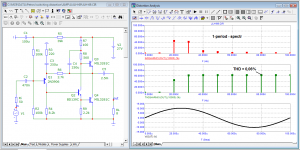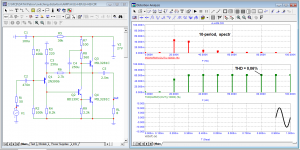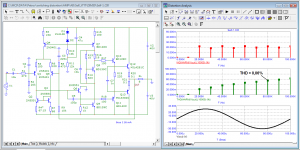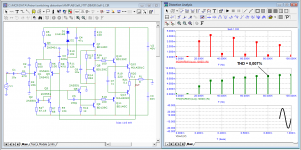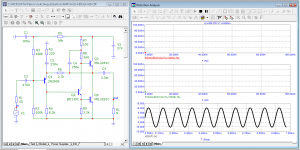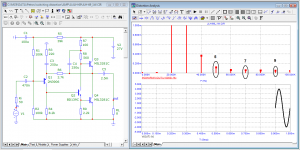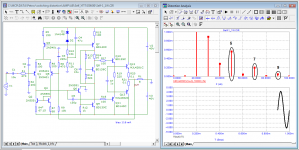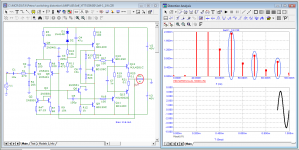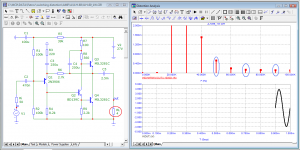Now pay attention to the operation of JLH-69 amplifier. The spectrum of its distortion does not depend on the period at which we measure them. This is the point that Graham tried unsuccessfully to convey
regards
regards
Attachments
If you had understood the explanation of the suddenly starting sine wave as a sinewave multiplied by a step function, you would have realized that these two simulations use exactly the same input signals and therefor must necessarily show the same spectrum. Which of course has nothing to do with what type of amp is used.
In fact, I find it nice that the simulations show exactly what would be predicted by theory.
Jan
In fact, I find it nice that the simulations show exactly what would be predicted by theory.
Jan
Anyway, the argument that has been going on is that test signals with step functions in them produce a spray of frequencies many of which are not audio-band frequencies. The question in relation to that has been more or less to the effect, "what is the justification for testing an audio amplifier with very high frequency RF, or other non-audio frequency test signals?"
I think the argument should be, don't expect that signal to look as as sine at simulation output.
/örjan
Jan, you once again did not understand anything.If you had understood the explanation of the suddenly starting sine wave as a sinewave multiplied by a step function, you would have realized that these two simulations use exactly the same input signals and therefor must necessarily show the same spectrum. Which of course has nothing to do with what type of amp is used.
In fact, I find it nice that the simulations show exactly what would be predicted by theory.
Jan
Compare the spectra of JLH-91 and Self-1 in the first and 10th periods.
The first has only the lowest harmonics at any period in the spectrum, except for the second and third there is nothing. And the spectrum of the second amplifier has higher harmonics of the same level as the lower harmonics.
Which amp would sound better for you?
Attachments
in fact, when measuring distortion at the 10th period, 10 periods come into the input, and the distortion measurements are made at the 10th.
The spectrum is responsible for the sound quality, not the level of distortion. Here is an example of the distortion of two systems.
The spectrum is responsible for the sound quality, not the level of distortion. Here is an example of the distortion of two systems.
Attachments
Jan, you once again did not understand anything.
Compare the spectra of JLH-91 and Self-1 in the first and 10th periods.
The first has only the lowest harmonics at any period in the spectrum, except for the second and third there is nothing. And the spectrum of the second amplifier has higher harmonics of the same level as the lower harmonics.
Which amp would sound better for you?
Yes you proved that two different amps perform differently. Was that your point in all these pages?
Jan
in fact, when measuring distortion at the 10th period, 10 periods come into the input, and the distortion measurements are made at the 10th.
The spectrum is responsible for the sound quality, not the level of distortion. Here is an example of the distortion of two systems.
So if I listen/measure an amp at one o'clock in the afternoon, and then again at two o'clock, you expect it to perform differently with the same input? Because that is what you do.
Jan
So, then you agree that measuring first cycle that start with an impulse, or 10mS later with the same impulse modulation, is exactly the same.
So that post # 624 is nonsense.
Glad we agree.
Jan
So that post # 624 is nonsense.
Glad we agree.
Jan
Not everyone believes that Graham designed the best sounding amplifiers ever. They sound pretty good, but there are better sounding ones. He was no John Lindsey Hood, so why hold him up as the best possible teacher of amplifier design?
Besides, not all good sounding amplifiers are super fast, there are just some people that don't know any other way to approach the problem.
Besides, not all good sounding amplifiers are super fast, there are just some people that don't know any other way to approach the problem.
'Best sounding' is so subjective as to be pretty much worthless as a metric. Some people swear by single-ended tube amps that start to roll off at 12k, others swear by a solid state amp flat out to 200k. And each one finds his amp best sounding. Go figure.
Jan
Jan
Not everyone believes that Graham designed the best sounding amplifiers ever. They sound pretty good, but there are better sounding ones. He was no John Lindsey Hood, so why hold him up as the best possible teacher of amplifier design?
Besides, not all good sounding amplifiers are super fast, there are just some people that don't know any other way to approach the problem.
Of course, Graham's amplifier does not claim to be the best, no one talks about it, including the humble Graham wrote about it. Graham only gave one of the directions in which to dig to develop a good amplifier in class AB.
Judging by the important statement, you know another way to get things done. If it's not a secret, share your thoughts ...
Jan, I appreciate humor, but only when it is in place. You will not deny that the CD recorded today will sound tomorrow and in 30 years (if it is not drunk to death).
petr_2009,
Do you know the harmonic analysis in MicroCap is FFT based, and therefore, a wrong tool for transient behavior analysis? Do you know why it is a wrong tool (answer is in this post)? Do you realize FFT accuracy is sensitive to transients? What measures did you take to make sure you do not get wrong answers because of using a wrong tool at a wrong signal, that consequently may lead to meaningless interpretation?
The first cycle harmonics charts may tell us the two amps do respond differently to the transient DURING the first cycle, but they tell almost nothing about the details, such as any overshoot or ringing, their amplitudes, how soon the amp settles after the transient hits (do they settle within 1% or 99% period of the cycle?), other than misleading the unsuspecting into believing there is "first cycle distortion" problem, just because the FFT works by cycles.
The harmonics chart made at 10th cycle is supposedly much better in accuracy than that of the first cycle, by cutting out the start-up transient and the 9 cycles trailing the transient. Naturally, it tells us nothing about what was going on during the first cycle, therefore off topic entirely. However it being off-topic, the interpretation to these charts depends on the way you look at them, and does not have to be the way you perceive.
The JLH may appears to have a much "cleaner" spectrum than what Self offers, but, if you zoom in on the y scale and work out the dB values against the reference, you'll have the following if we look at only 3rd and 7th, which is in favor of JLH:
JLH: 3rd: -48dB, 7th: -70dB
Self: 3rd: -77dB, 7th: -80dB
you can easily work out the other harmonics yourself.
Obviously, not only at higher harmonics does JLH produce higher level peaks than Self, but also its 2nd and third are horrendously higher. It is much more distortive than Self.
If fidelity, AKA low distortion, is anywhere remotely relevant, Self's is no doubt the better one between the two, shown by your charts.
This is not to say you can't take the more distortive amp as your pick of "good sounding" amp between the two, but to say that you need to keep in mind what sounds good is preference/bias, often on irrational basis, therefore, often not subject to discussion, and that your preference is no superior than that of anyone else.
Do you know the harmonic analysis in MicroCap is FFT based, and therefore, a wrong tool for transient behavior analysis? Do you know why it is a wrong tool (answer is in this post)? Do you realize FFT accuracy is sensitive to transients? What measures did you take to make sure you do not get wrong answers because of using a wrong tool at a wrong signal, that consequently may lead to meaningless interpretation?
The first cycle harmonics charts may tell us the two amps do respond differently to the transient DURING the first cycle, but they tell almost nothing about the details, such as any overshoot or ringing, their amplitudes, how soon the amp settles after the transient hits (do they settle within 1% or 99% period of the cycle?), other than misleading the unsuspecting into believing there is "first cycle distortion" problem, just because the FFT works by cycles.
The harmonics chart made at 10th cycle is supposedly much better in accuracy than that of the first cycle, by cutting out the start-up transient and the 9 cycles trailing the transient. Naturally, it tells us nothing about what was going on during the first cycle, therefore off topic entirely. However it being off-topic, the interpretation to these charts depends on the way you look at them, and does not have to be the way you perceive.
The JLH may appears to have a much "cleaner" spectrum than what Self offers, but, if you zoom in on the y scale and work out the dB values against the reference, you'll have the following if we look at only 3rd and 7th, which is in favor of JLH:
JLH: 3rd: -48dB, 7th: -70dB
Self: 3rd: -77dB, 7th: -80dB
you can easily work out the other harmonics yourself.
Obviously, not only at higher harmonics does JLH produce higher level peaks than Self, but also its 2nd and third are horrendously higher. It is much more distortive than Self.
If fidelity, AKA low distortion, is anywhere remotely relevant, Self's is no doubt the better one between the two, shown by your charts.
This is not to say you can't take the more distortive amp as your pick of "good sounding" amp between the two, but to say that you need to keep in mind what sounds good is preference/bias, often on irrational basis, therefore, often not subject to discussion, and that your preference is no superior than that of anyone else.
Last edited:
Jan, I appreciate humor, but only when it is in place. You will not deny that the CD recorded today will sound tomorrow and in 30 years (if it is not drunk to death).
I was dead serious. Follow the reasoning, you will agree.
Jan
Now I will show you how you make mistakes with your own hands when modeling.no theory will help you, so you don't understand how measurements take place in the simulator
Att. 1:
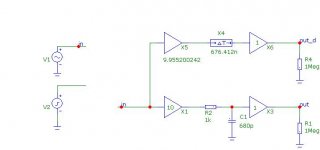
We take the ideal amplification unit and set a certain pole with the RC circuit. Such an analog amplifier does not have nonlinear distortions, but only linear ones, including the response to the transition function. You like to use the perfect delay macro to compensate for lag at the top I've built a similar channel using it. OK, let's see what the different signal stimulation tests show us.
Att.2:
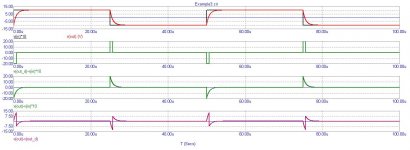
First, we apply a square wave to the input and observe on the second graph from above the Delta between the output of the delay macro and the input signal scaled to the output. On the third from the top, the Delta between the output with the RC circuit and the input signal scaled to the output. In the lower graph, we have a Delta between two different implementations of the shift.
As we can see, the RC circuit generates a transient on each front. But the macro simply shifts the signal for a given time and does not have a transient process. As a result, the difference between the options is obvious. And the conclusion from this is the same-the use of the delay macro introduces a step effect and provokes a transition process.
Att. 3:
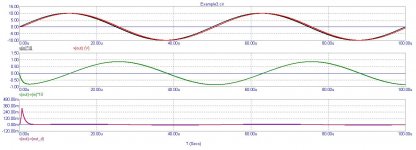
Let's feed the sine and see what the difference between the outputs will be. In the lower graph, we see the transition process generated by the start of the sine from the standard generator. But further, when transitions through zero, there are no transients, which indicates that the function is inseparable and does not have hidden step effects. That is why you need to wait for some time from the first period and only then start capturing the time window of the Fourier transform and decomposing it into a spectrum. And the larger the time constant of the amplifier (already the band), the longer it should wait. Otherwise, we will capture the transition curve that I showed in post 612 in the window. This will distort the result and we will end up with a false measurement.
What is happening in essence? Analysis using Fourier expansion should show us nonlinear distortions of the gain channel, that is, those that depend on the amplitude and transfer function of the active element (lamp, transistor). In this case, there should be no transition in the analysis time window. To simplify the life of users, the authors of the simulator even introduced the "Periodic Steady State" marker in the analysis settings, which allows you to start the analysis itself only after the transition process is completed (you can also set the decision conditions manually).
Use the tools correctly, do not nail up the nails with a microscope! I hope that I have told you clearly enough how measurements occur in the simulator and you will understand that they do not contradict the theory. You just don't know the theory and refuse to study it.
nattawa, I still did not understand what you measured, in what modes the spectra were taken. The screenshots are the most graphic. It is generally accepted that an indicator of quality is the operation of the amplifier at a power of 1 Watt. Here are the test results for the tenth period of the two amplifiers. I hope it is clear which one is in a better position. I am silent about the first period, since you do not listen to music from the first period, most likely you listen in non-stop dancing modeThe JLH may appears to have a much "cleaner" spectrum than what Self offers, but, if you zoom in on the y scale and work out the dB values against the reference, you'll have the following if we look at only 3rd and 7th, which is in favor of JLH:
JLH: 3rd: -48dB, 7th: -70dB
Self: 3rd: -77dB, 7th: -80dB
you can easily work out the other harmonics yourself.
Attachments
No it isn't.It is generally accepted that an indicator of quality is the operation of the amplifier at a power of 1 Watt.
nattawa, I still did not understand what you measured, in what modes the spectra were taken.
I did not measure anything, all is in the charts in your own posts.
The JHL on 10th cycle is Here with post #621
The Self on 10th cycle is Here with post #624
You specifically used the above charts as supporting data to convince us the JLH being superior of the two.
It is generally accepted that an indicator of quality is the operation of the amplifier at a power of 1 Watt.
Once again you're making things up as you go. Bravo.
You do not need new graphs. The above two that you posted earlier as your supporting data are more than good enough for you to work the dB numbers out.
I did not measure anything, all is in the charts in your own posts.
The JHL on 10th cycle is Here with post #621
The Self on 10th cycle is Here with post #624
JLH: 3rd: -48dB, 7th: -70dB
Self: 3rd: -77dB, 7th: -80dB
You specifically used the above charts as supporting data to convince us the JLH being superior of the two. The above two that you posted earlier as your supporting data are more than good enough for you to work the dB numbers out.
Just to be clear for those like me who have skimmed a little, the JHL model is using a 10Vp output signal and shows first and second harmonics up over 40mV which compresses the scale for the lower level later harmonics. The model for the Self amp is using a 30Vp signal and all harmonics are less than 5mV.
I can't see the exact values of later harmonics for the JHL, but it's clear that the early harmonics dominate at a very high level comparatively and represents a different harmonic spectral case to the Self.
Using a dB scale for harmonic amplitude with the fundamental at 0 would have been much easier for readers to understand, regardless of the merits of any other points being made here.
One of the colleagues shared his experience. Sometimes at guests it turns on a tube amplifier with a 2nd harmonic level of up to 12%. None of the guests have yet made a comment that his music is distorted.
Above, I gave an example of a bad (with less distortion) and good (with more distortion) system. The sound quality determines the spectrum. And if it is below the level of the ear harmonics, then we perceive the sound as undistorted.
The second reason why one should pay attention to spectra at low power is the Weber-Fechner effect, which consists in the logarithmic amplitude characteristic of human hearing. People against the background of high signal levels distinguish well weak signals with their spectra and distortions. Already at a level of 80-90 dB, the hearing itself generates harmonics (up to 7% in the second harmonic). The tail of the harmonics falls off quickly. Nevertheless, we can hear everything that is higher than the ear harmonics, especially the higher harmonics.
And of course, do not forget that the speaker system is not an 8 Ohm resistor, its impedance can significantly drop, up to negative values due to back-EMF - this is what Graham wrote about. And here it is important that the amplifier does a good job with both reactive impedance and low impedance loads.
And here it is important that it reacts instantly and in phase with external influence, as amplifiers do without feedback.
Above, I gave an example of a bad (with less distortion) and good (with more distortion) system. The sound quality determines the spectrum. And if it is below the level of the ear harmonics, then we perceive the sound as undistorted.
The second reason why one should pay attention to spectra at low power is the Weber-Fechner effect, which consists in the logarithmic amplitude characteristic of human hearing. People against the background of high signal levels distinguish well weak signals with their spectra and distortions. Already at a level of 80-90 dB, the hearing itself generates harmonics (up to 7% in the second harmonic). The tail of the harmonics falls off quickly. Nevertheless, we can hear everything that is higher than the ear harmonics, especially the higher harmonics.
And of course, do not forget that the speaker system is not an 8 Ohm resistor, its impedance can significantly drop, up to negative values due to back-EMF - this is what Graham wrote about. And here it is important that the amplifier does a good job with both reactive impedance and low impedance loads.
And here it is important that it reacts instantly and in phase with external influence, as amplifiers do without feedback.
Attachments
- Home
- Amplifiers
- Solid State
- First cycle distortion - Graham, what is that?
